Advanced ECMS for Hybrid Electric Heavy-Duty Trucks with Predictive Battery Discharge and Adaptive Operating Strategy under Real Driving Conditions
Abstract
1. Introduction
2. Vehicle Model
2.1. Longitudinal Dynamics
2.2. Drive Units
2.3. Battery
2.4. Driving Cycles
3. Development of Energy Management Strategy
3.1. Rule Based
3.2. Global Optimal Control—DP
3.3. ECMS
3.4. Application of ECMS to HEV-HD Trucks
4. Development of Predictive Battery Discharge for ECMS
4.1. Functional Requirements and Parameter Defintion
4.2. Impact and Tuning of the Paramters
4.3. Predictive Operating Strategy
5. Advanced ECMS with Predictive Battery Discharge and Driving Condition Recognition
5.1. Application and Adjustment of DCR for Adaptive Equivalent Factor Selection
5.2. Structure of the Implemented ECMS
5.3. Analysis of Operating Strategy of Intelligent ECMS
6. Comparison of EMS and Discussion of the Results
6.1. Impact of Predictive Discharge—PBDis
6.2. Adaption of Operating Strategy—DCR
6.3. Discussion
7. Conclusions
Author Contributions
Funding
Data Availability Statement
Conflicts of Interest
Appendix A. Equivalent Fuel Mass
Appendix B. Parameters and for Training Cycles
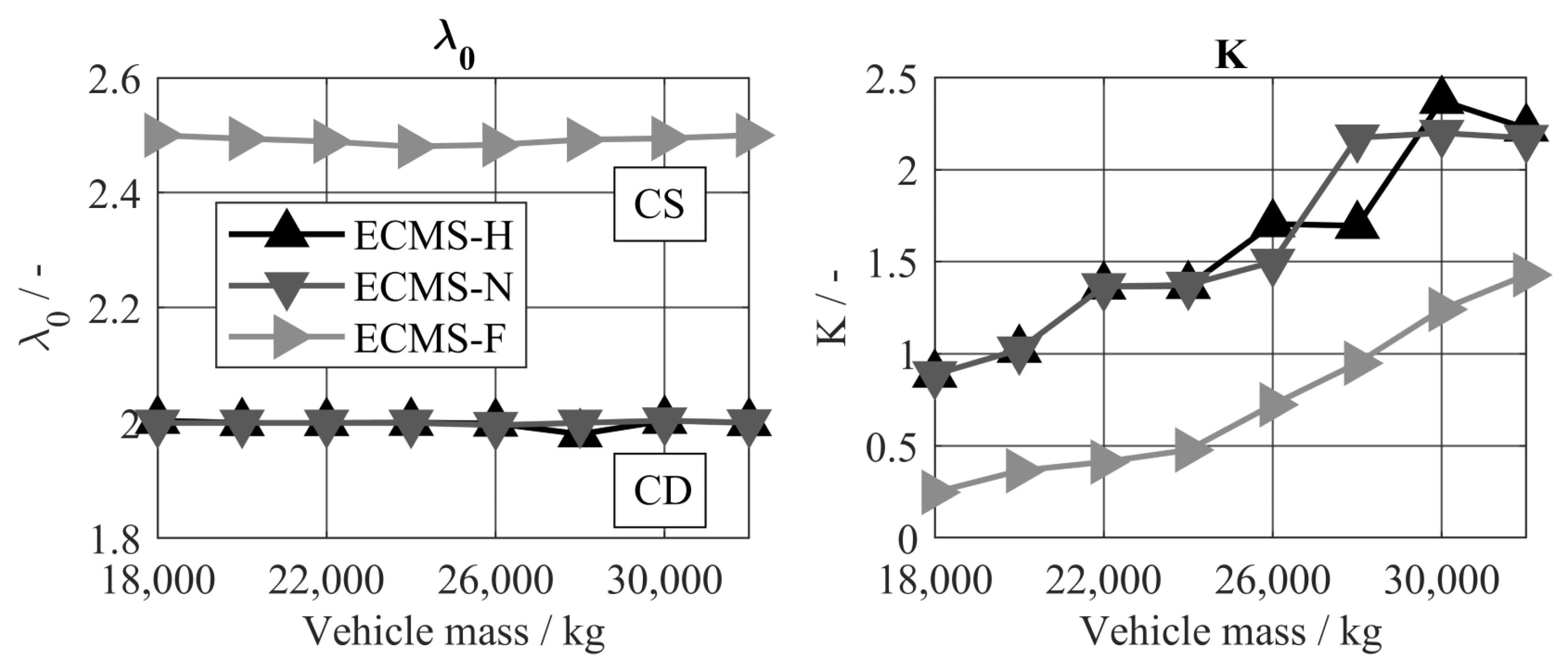
Appendix C. Parameters , , and for Training Cycles
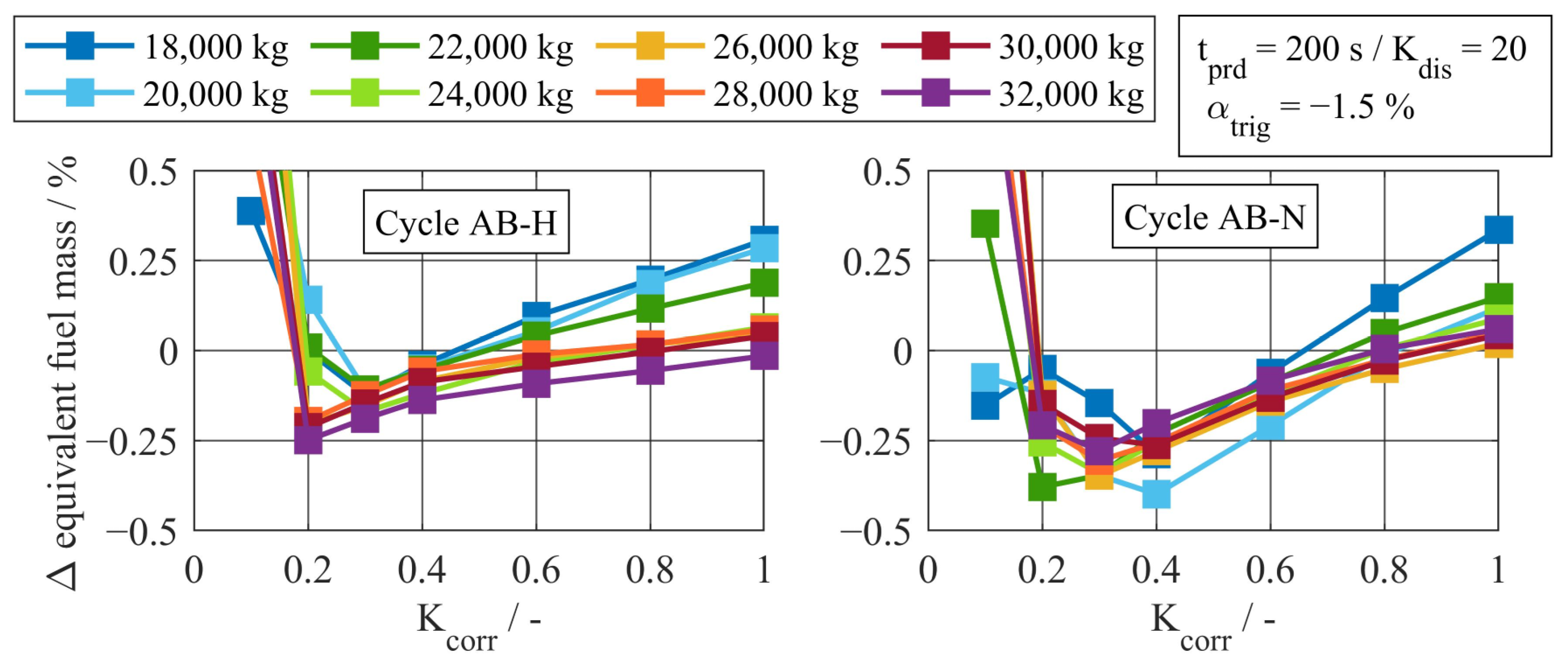
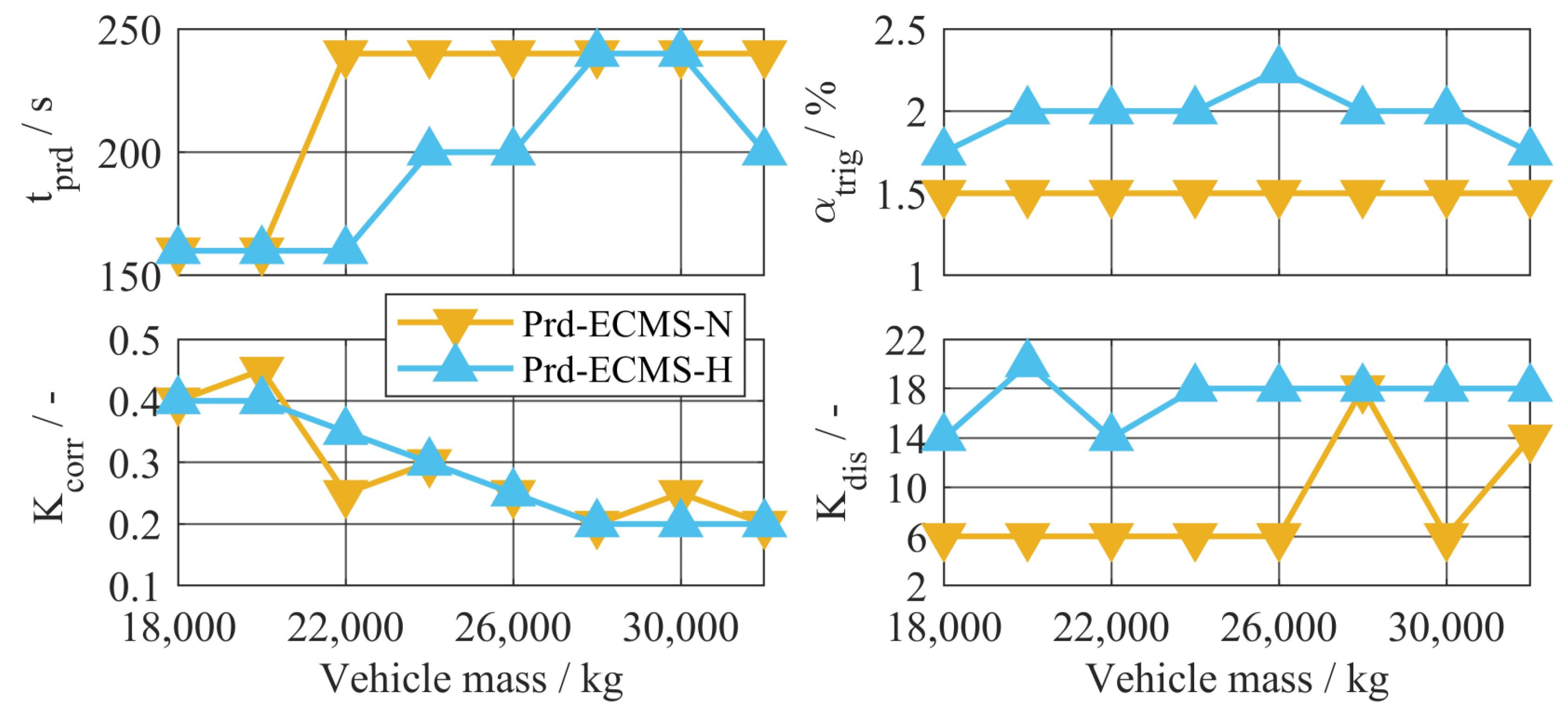
Appendix D. Driving Cycles

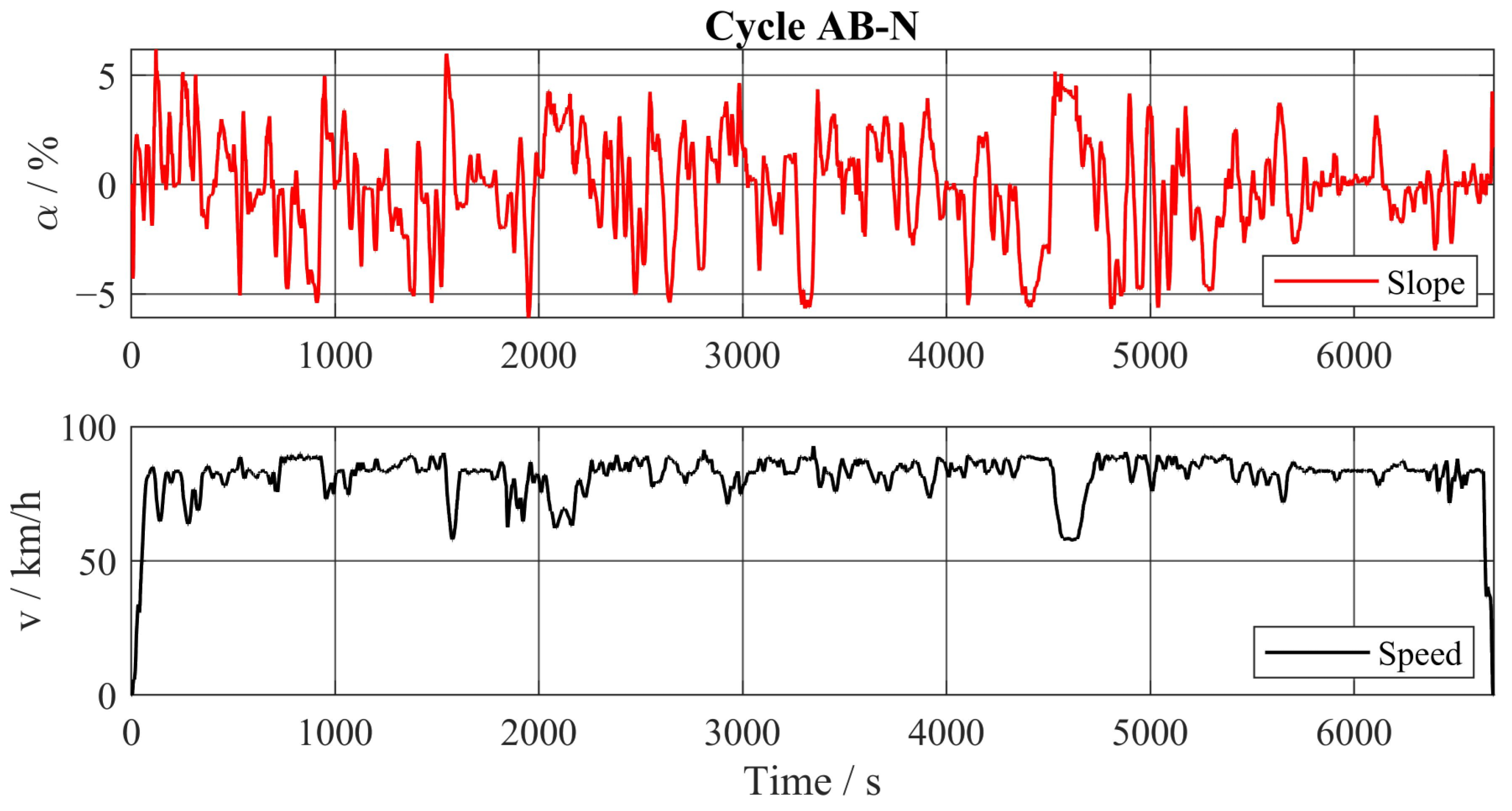
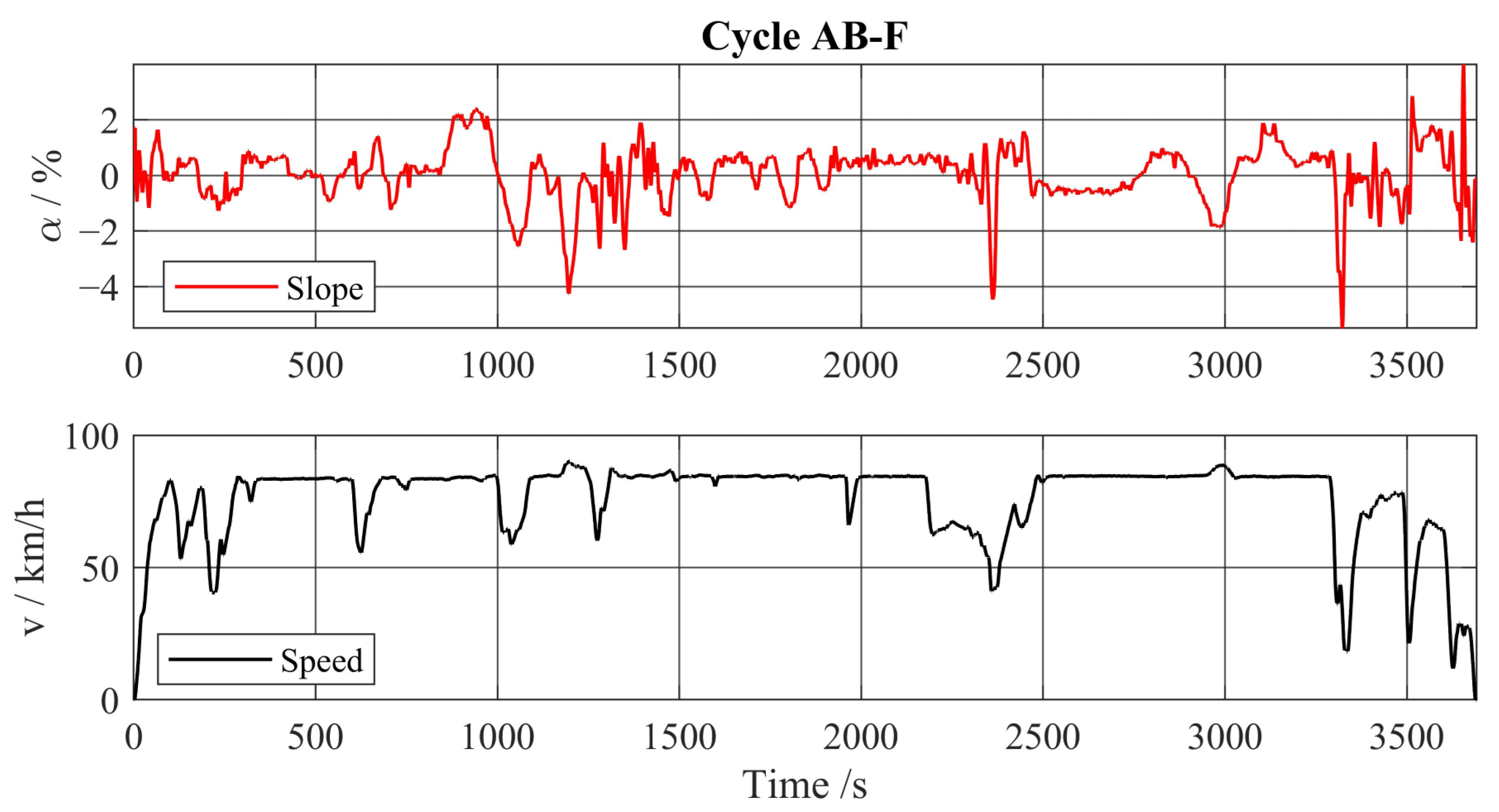
References
- Europäische Union. Verordnung (EU) 2019/des Europäischen Parlaments und des Rates Vom 20 Juni 2019 zur Festlegung von CO2-Emissionsnormen für Neue Schwere Nutzfahrzeuge und zur Änderung der Verordnungen (EG) Nr. 595/2009 und (EU) 2018/956 des Europäischen Parlaments und des Rates Sowie der Richtlinie 96/53/EG des Rates. Verordnung (EU) 2019/des Europäischen Parlaments und des Rates vom 20. Juni 2019 zur Festlegung von CO2-Emissionsnormen für Neue Schwere Nutzfahrzeuge und zur Änderung der Verordnungen (EG) Nr. 595/2009 und (EU) 2018/956 des Europäischen Parlaments und des Rates Sowie der Richtlinie 96/53/EG des Rates. 2019. Available online: https://eur-lex.europa.eu/legal-content/DE/TXT/PDF/?uri=CELEX:32019R1242&from=EN (accessed on 23 January 2020).
- European Automobile Manufacturers Association. VECTO: Bringing down CO2 Emissions and Fuel Costs of Heavy-Duty Vehicles by Promoting Transparency, Vehicle Comparability and Competition. Available online: http://www.acea.be/uploads/publications/VECTO_infographic.pdf (accessed on 8 September 2021).
- Helbing, M. Energiemanagement für eine Parallele Hybridarchitektur. Diploma Thesis, TU Dresden, Dresden, Germany, 2014. [Google Scholar]
- Bertsekas, D.P. Dynamic Programming and Optimal Control, 3rd ed.; Athena Scientific (Athena Scientific Optimization and Computation Series 3): Belmont, MA, USA, 2005. [Google Scholar]
- Sundström, O.; Guzzella, L. A Generic Dynamic Programming Matlab Function. In Proceedings of the 18th IEEE International Conference on Control Applications, St. Petersburg, Russia, 8–10 July 2009. [Google Scholar]
- Back, M. Prädiktive Antriebsregelung zum Energieoptimalen Betrieb von Hybridfahrzeugen. Ph.D. Thesis, Universität Karlsruhe, Karlsruhe, Germany, 2005. [Google Scholar]
- Serrao, L. A Comparative Analysis of Energy Management Strategies for Hybrid Electric Vehicles. J. Dyn. Sys. Meas. Control 2011, 133, 031012. [Google Scholar] [CrossRef]
- Paganelli, G.; Delprat, S.; Guerra, T.M.; Rimaux, J.; Santin, J.J. Equivalent consumption minimization strategy for parallel hybrid powertrains. In Proceedings of the Vehicular Technology Conference. IEEE 55th Vehicular Technology Conference. VTC Spring 2002 (Cat. No.02CH37367), Birmingham, AL, USA, 6–9 May 2002. [Google Scholar]
- Musardo, C.; Rizzoni, G.; Guezennec, Y.; Staccia, B. A-ECMS: An Adaptive Algorithm for Hybrid Electric Vehicle Energy Management. Eur. J. Control 2005, 11, 509–524. [Google Scholar] [CrossRef]
- Onori, S.; Serrao, L.; Rizzoni, G. Adaptive Equivalent Consumption Minimization Strategy for Hybrid Electric Vehicles. In Proceedings of the ASME 2010 Dynamic Systems and Control Conference, Cambridge, MA, USA, 12–15 September 2010. [Google Scholar]
- Lampe, A. A Rule-Based Operating Strategy for the Pre-Design of a Powertrain for Hybrid Electric Vehicles. ATZ Worldw. 2014, 116, 56–62. [Google Scholar] [CrossRef]
- Finesso, R.; Spessa, E.; Venditti, M. Robust equivalent consumption-based controllers for a dual-mode diesel parallel HEV. Energy Convers. Manag. 2016, 127, 124–139. [Google Scholar] [CrossRef]
- Görke, D.; Bargende, M.; Keller, U.; Ruzicka, N.; Schmiedler, S. Kraftstoffoptimale Auslegung Regelbasierter Betriebsstrategien für Parallelhybridfahrzeuge unter Realen Fahrbedingungen. 2014. Available online: https://docplayer.org/45190335-Kraftstoffoptimale-auslegung-regelbasierter-betriebsstrategien-fuer-parallelhybridfahrzeuge-unter-realen-fahrbedingungen.html (accessed on 20 May 2023).
- Sciarretta, A.; Guzzella, L. Control of Hybrid Elctric Vehicles. IEEE Control Syst. Mag. 2007, 27, 60–70. [Google Scholar]
- Rizzoni, G.; Onori, S. Energy Management of Hybrid Electric Vehicles: 15 years of development at the Ohio State University. Oil Gas Sci. Technol. Rev. D’ifp Energ. Nouv. 2015, 70, 41–54. [Google Scholar] [CrossRef]
- Salmasi, F.R. Control Strategies for Hybrid Electric Vehicles: Evolution, Classification, Comparison, and Future Trends. IEEE Trans. Veh. Technol. 2007, 56, 2393–2404. [Google Scholar] [CrossRef]
- Helbing, M.; Uebel, S.; Tempelhahn, C.; Bäker, B. An Evaluated Review of Powertrain Control Strategies for Hybrid Electrical Vehicles. ATZelektronik Worldw. 2015, 10, 46–51. [Google Scholar] [CrossRef]
- Pisu, P.; Rizzoni, G. A Comparative Study of Supervisory Control Strategies for Hybrid Electric Vehicles. IEEE Trans. Control. Syst. Technol. 2007, 15, 506–518. [Google Scholar] [CrossRef]
- Huang, Y.; Jiang, F.; Xie, H. Adaptive hierarchical energy management design for a novel hybrid powertrain of concrete truck mixers. J. Power Sources 2021, 509, 230325. [Google Scholar] [CrossRef]
- Feng, Y.; Dong, Z. Optimal energy management with balanced fuel economy and battery life for large hybrid electric mining truck. J. Power Sources 2020, 454, 227948. [Google Scholar] [CrossRef]
- Yang, C.; Du, S.; Li, L.; You, S.; Yang, Y.; Zhao, Y. Adaptive real-time optimal energy management strategey based on equivalent factors optimization for plug-in hybrid electric vehicle. Appl. Energy 2017, 203, 883–896. [Google Scholar] [CrossRef]
- van Keulen, T.; van Mullem, D.; de Jager, B.; Kessels, J.T.; Steinbuch, M. Design, implementation, and experimental validation of optimal power split control for hybrid electric trucks. Control. Eng. Pr. 2012, 20, 547–558. [Google Scholar] [CrossRef]
- Zhang, P.; Wu, X.; Du, C.; Xu, H.; Wang, H. Adaptive Equivalent Consumption Minimization Strategy for Hybrid Heavy-Duty Truck Based on Driving Condition Recognition and Parameter Optimization. Energies 2020, 13, 5407. [Google Scholar] [CrossRef]
- Schulze, S.; Feyerl, G.; Pischinger, S.; Mühleisen, M. Adaptive Energy Management Strategy for a Heavy-Duty Truck with a P2-Hybrid Topology. In 18. Internationales Stuttgarter Symposium: Automobil-und Motorentechnik; Bargende, M., Reuss, H., Wiedemann, J., Eds.; Springer: Berlin/Heidelberg, Germany, 2018. [Google Scholar]
- Schulze, S.; Feyerl, G. Sensitivity Study of an Adaptive Energy Management Strategy for Heavy Vehicle Application with a P2-Hybrid Topology. In Proceedings of the 4th Int. Diesel Powertrains 3.0 Conference, Coventry, UK, 3–4 July 2018. [Google Scholar]
- Sonntag, M.; Sawodny, O.; Kaufmann, F.; Gehring, O. Vorausschauendes HV-Batteriemanagement für E-Hybrid LKW im Fernverkehr. In Proceedings of the 6th VDI/VDE-Fachtagung Steuerung und Regelung von Fahrzeugen und Motoren, Baden-Baden, Germany, 5–6 June 2013. [Google Scholar]
- Arts, G.J.C.M. Analysis and Synthesis of Hybrid Truck Energy Management. Master’s Thesis, TU Eindhoven, Eindhoven, The Netherlands, 2007. [Google Scholar]
- Merker, G.P.; Teichmann, R. Grundlagen Verbrennungsmotoren: Funktionsweise, Simulation, Messtechnik, 7th ed.; Springer Fachmedien Wiesbaden: Wiesbaden, Germany, 2014. [Google Scholar]
- Kreyer, J.; Müller, M.; Esch, T. A Calculation Methodology for Predicting Exhaust Mass Flows and Exhaust Temperature Profiles for Heavy-Duty Vehicles. SAE Int. J. Commer. Veh. 2020, 13. [Google Scholar] [CrossRef]
- Quickert, M. Höhenprofile von Autobahnen. Höhenprofile von Autobahnen. 2014. Available online: http://www.ahph.de/ (accessed on 20 April 2020).
- ETH Zürich. Homepage Institue for Dynamic Systems and Control. Available online: http://www.idsc.ethz.ch/research-guzzella-onder/downloads.html (accessed on 8 September 2021).
- Jeon, S.-I.; Jo, S.-T.; Park, Y.-I.; Lee, J.-M. Multi-Mode Driving Control of a Parallel Hybrid Electric Vehicle Using Driving Pattern Recognition. J. Dyn. Syst. Meas. Control. 2000, 124, 141–149. [Google Scholar] [CrossRef]
- Beidl, C.; Schmitt, M.; Kluin, M.; Lenzen, B. Potenziale hybridisierter Nutzfahrzeuge. MTZ Mot. Z. 2011, 72, 432–437. [Google Scholar] [CrossRef]
- Treusch, S. Hybrid at Daimler Trucks—Technology for the World: Current Status and Working Direction (4. Fachtagung Hybridantriebe für Mobile Antriebsmaschinen). Karlsruhe, 20 February 2013. Available online: https://www.fast.kit.edu/download/DownloadsMobima/Veroeffentlichung_Hybridtagung_Daimler_Treusch_22022013.pdf (accessed on 20 April 2020).
- García, A.; Monsalve-Serrano, J.; Martinez-Boggio, S.; Gaillard, P. Emissions reduction by using e-components in 48 V mild hybrid trucks under dual-mode dual-fuel combustion. Appl. Energy 2021, 299, 117305. [Google Scholar] [CrossRef]
- García, A.; Monsalve-Serrano, J.; Martinez-Boggio, S.; Gaillard, P. Impact of the hybrid electric architecture on the performance and emissions of a delivery truck with a dual-fuel RCCI engine. Appl. Energy 2021, 301, 117494. [Google Scholar] [CrossRef]
- Feru, E.; Murgovski, N.; de Jager, B.; Willems, F. Supervisory control of a heavy-duty diesel engine with an electrified waste heat recovery system. Control. Eng. Pr. 2016, 54, 190–201. [Google Scholar] [CrossRef]
- Marlok, H.; Pfeifer, A.; Hötger; Bucher, M. Modulares Abwärmerückgewinnungssytem mit elektrischer Leistungsabgabe. MTZ Mot. Z. 2019, 80, 84–89. [Google Scholar]
- Verbruggen, F.J.R.; Rangarajan, V.; Hofman, T. Powertrain design optimization for a battery electric heavy-duty truck. In Proceedings of the 2019 American Control Conference, ACC 2019, Philadelphia, PA, USA, 10–12 July 2019; Institute of Electrical and Electronics Engineers: Piscataway, NJ, USA, 2019; pp. 1488–1493. [Google Scholar]
- Verbruggen, F.J.R.; Hofman, T. Design Sensitivity Analysis for Heavy-Duty Hybrid Electric Trucks with a Waste Heat Recovery System. In Proceedings of the 2017 IEEE Vehicle Power and Propulsion Conference (VPPC), Belfort, France, 11–14 December 2017; pp. 1–6. [Google Scholar] [CrossRef]
- Silvas, E.; Hereijgers, K.; Peng, H.; Hofman, T.; Steinbuch, M. Synthesis of Realistic Driving Cycles With High Accuracy and Computational Speed, Including Slope Information. IEEE Trans. Veh. Technol. 2016, 65, 4118–4128. [Google Scholar] [CrossRef]
- Banerjee, A.; Würthner, M.; Tudoise, C. Prevision GPS—Die Schaltstrategie für das Getriebesystem Traxon. ATZ 2013, 115, 490–493. [Google Scholar] [CrossRef]
- Ferrara, A.; Jakubek, S.; Hametner, C. Energy management of heavy-duty fuel cell vehicles in real-world driving scenarios: Robust design of strategies to maximize the hydrogen economy and system lifetime. Energy Convers. Manag. 2021, 232, 113795. [Google Scholar] [CrossRef]
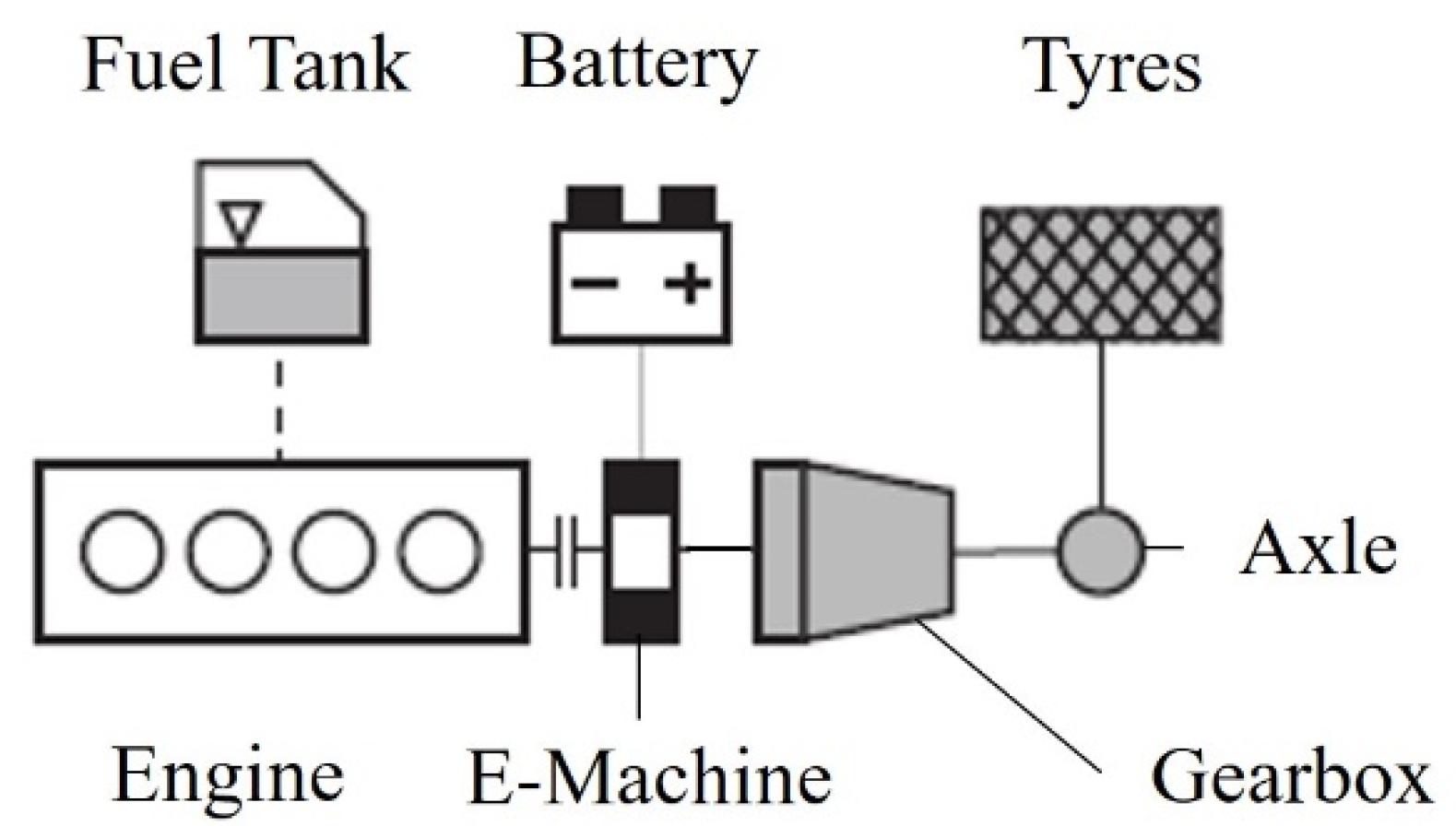
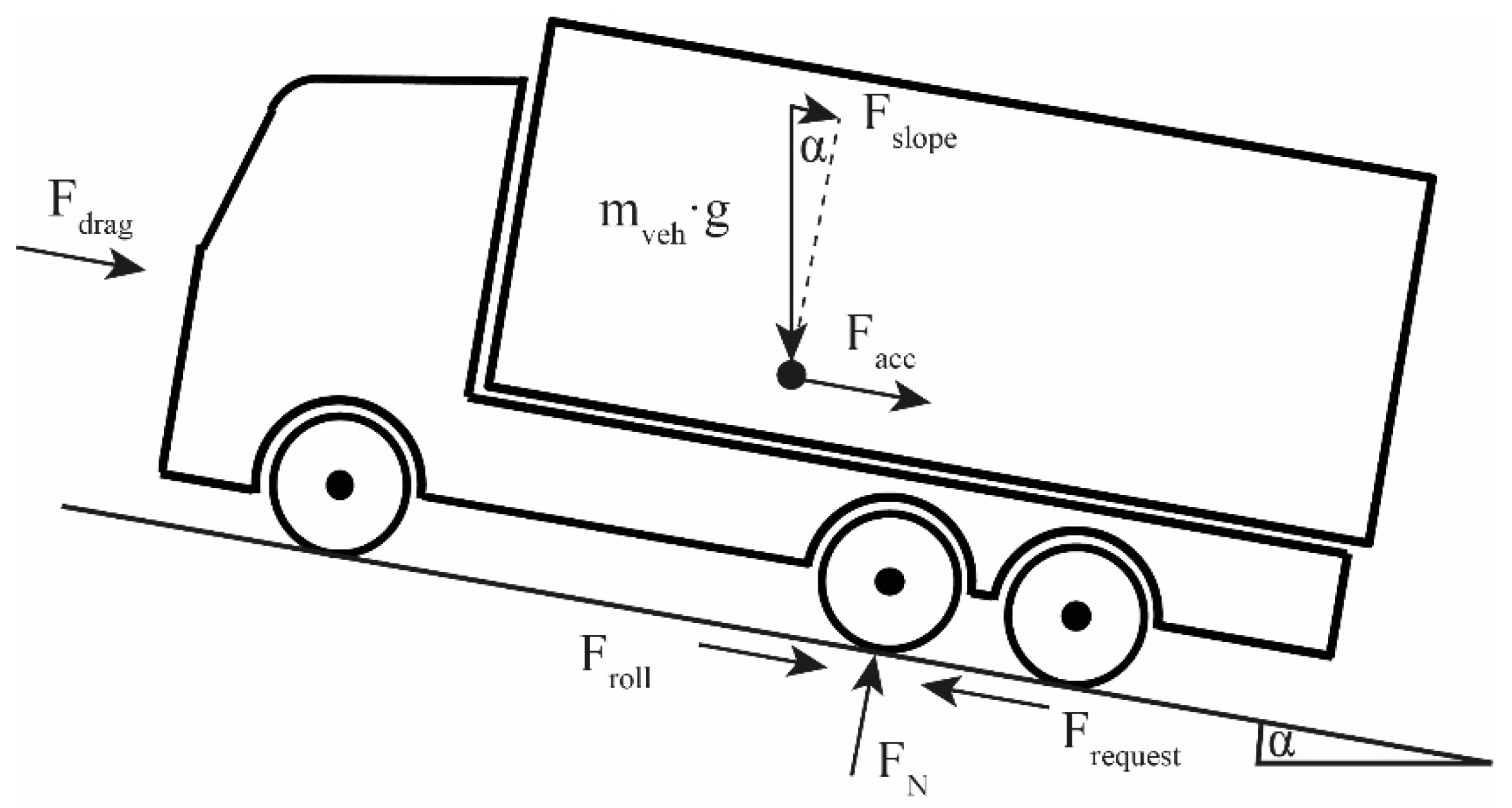


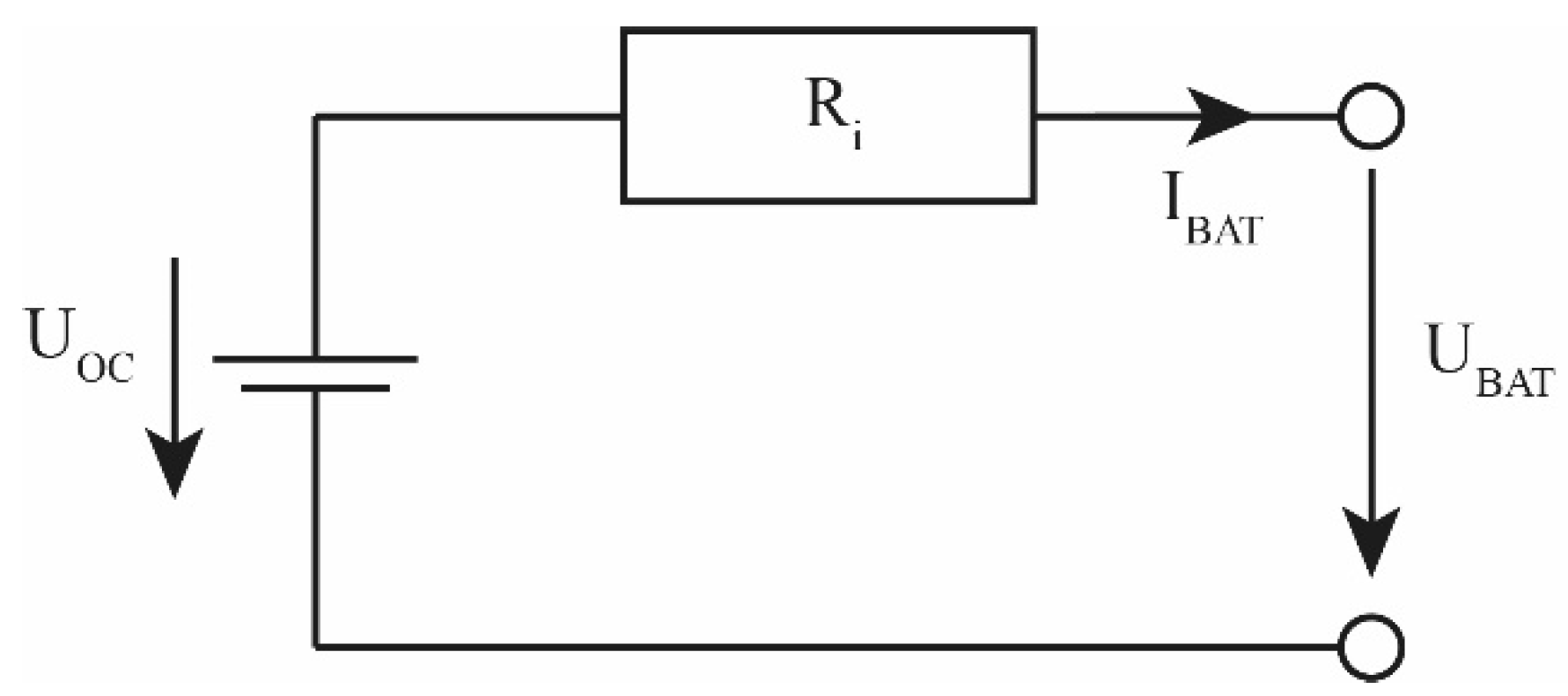
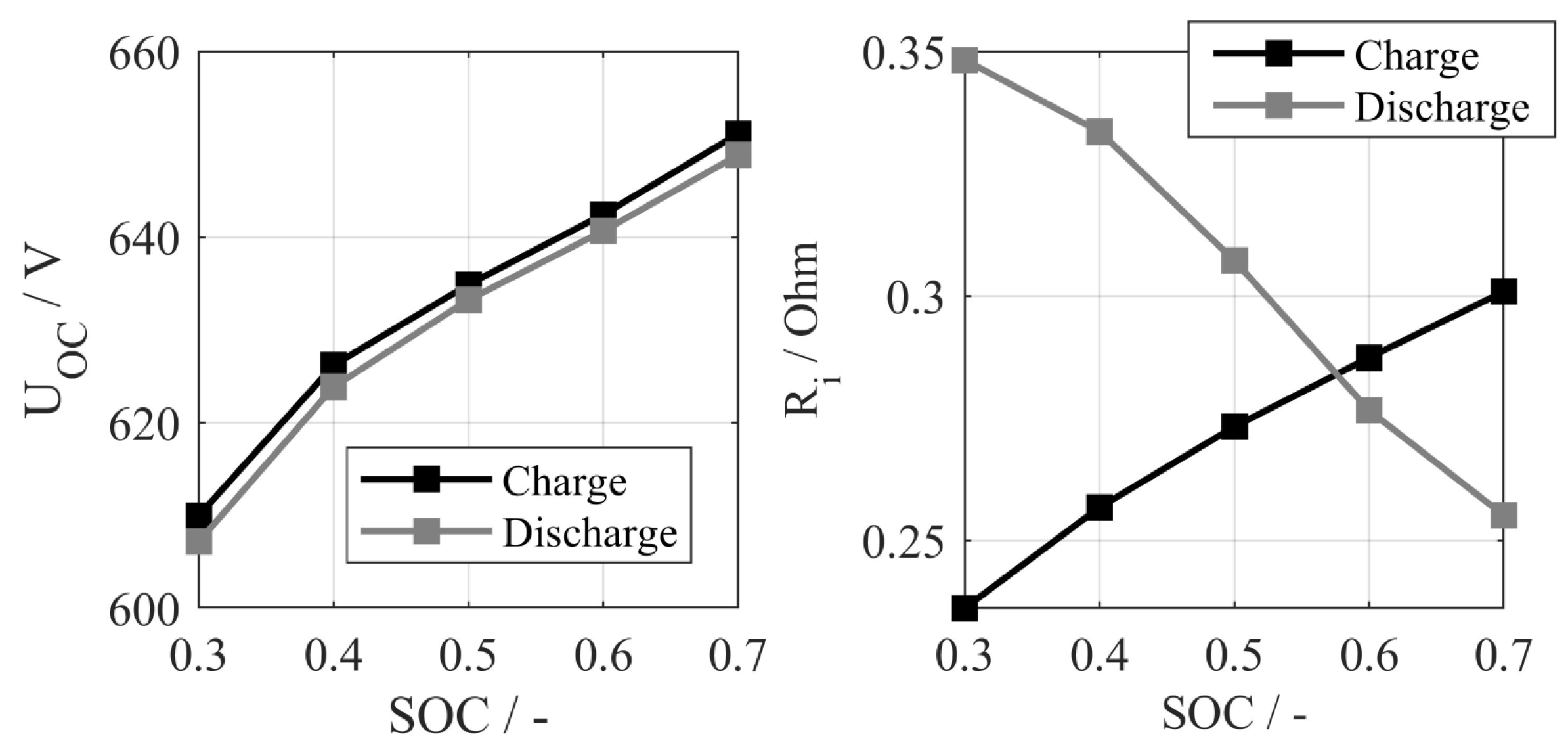
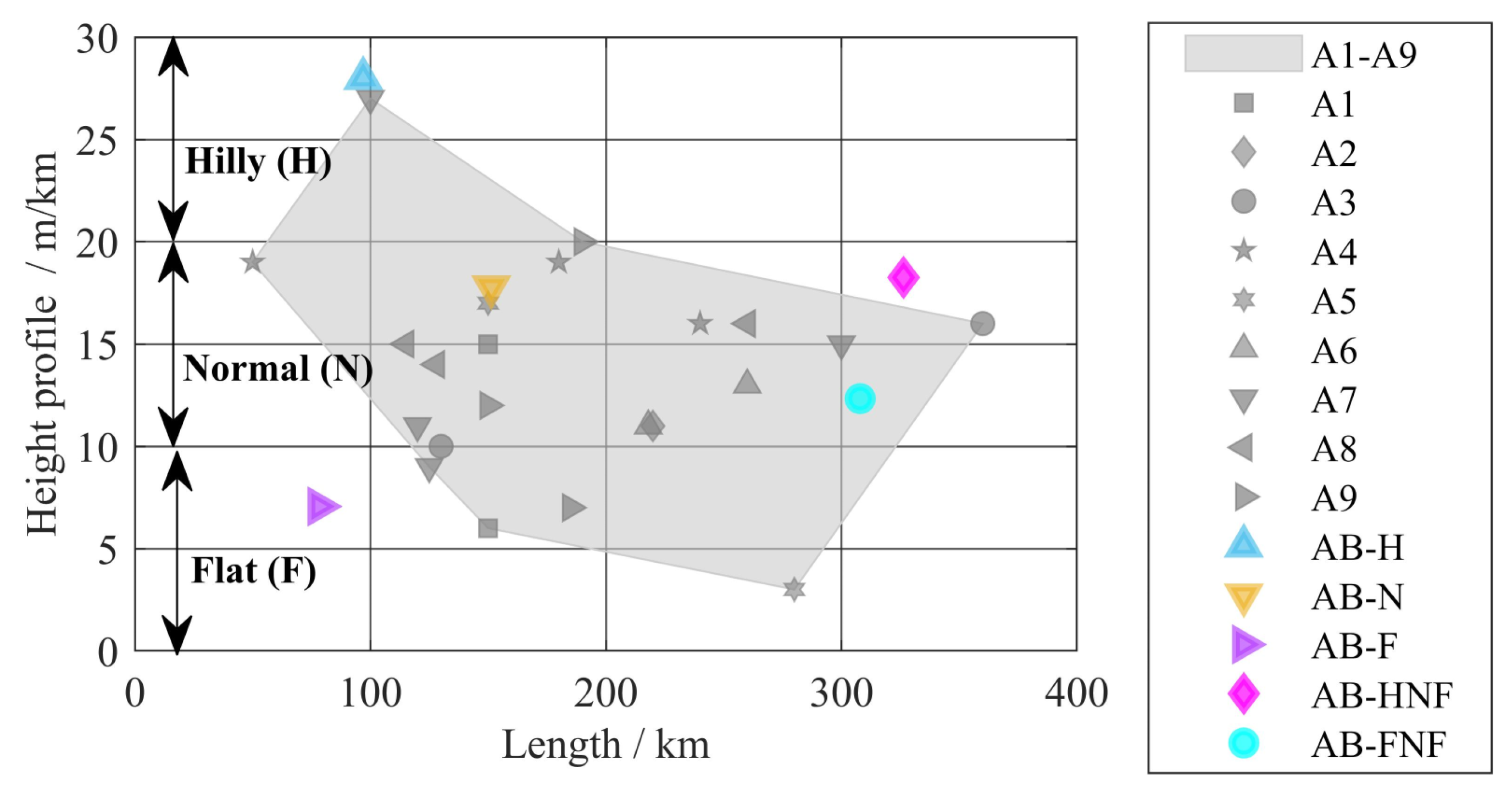



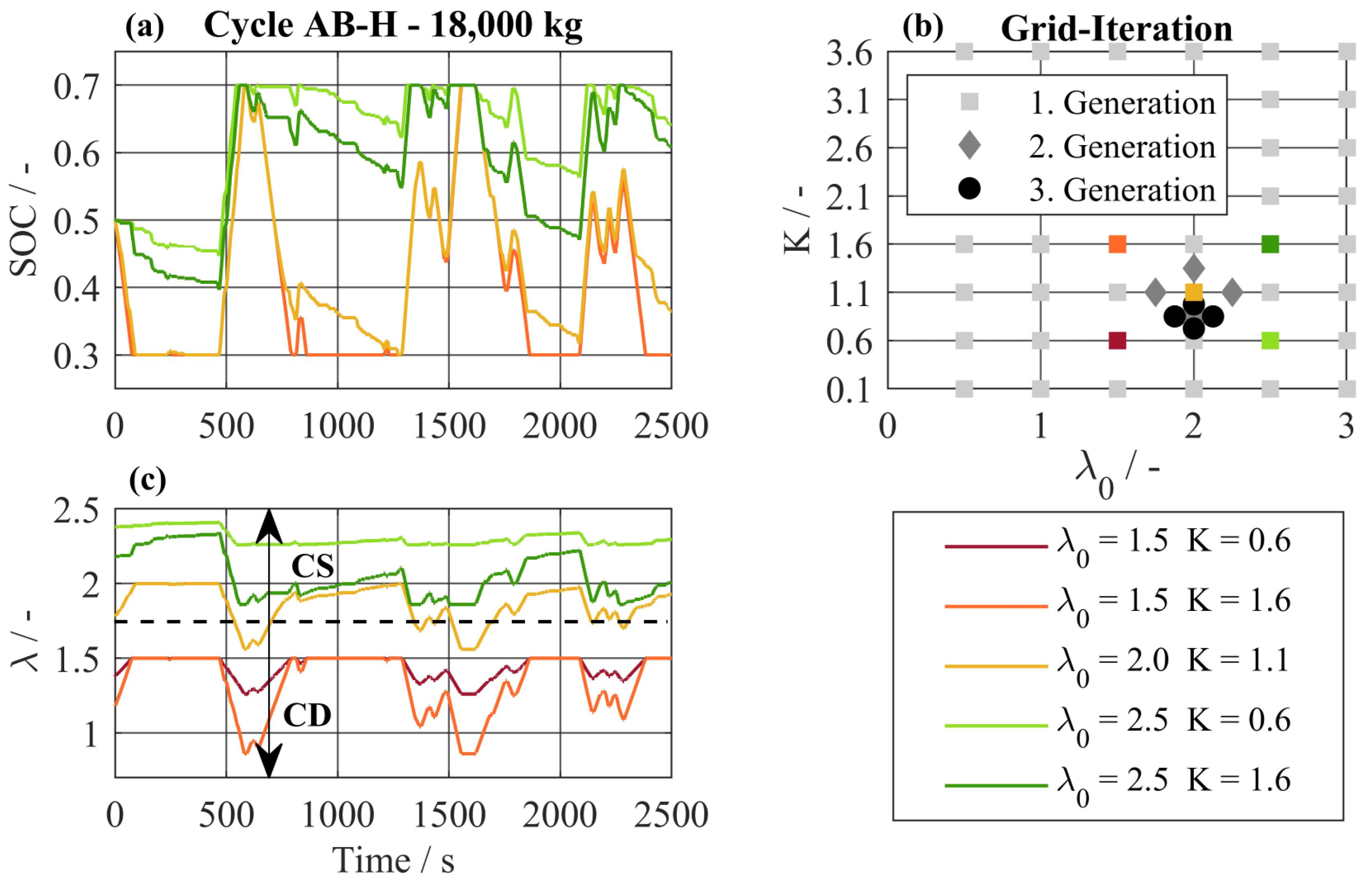
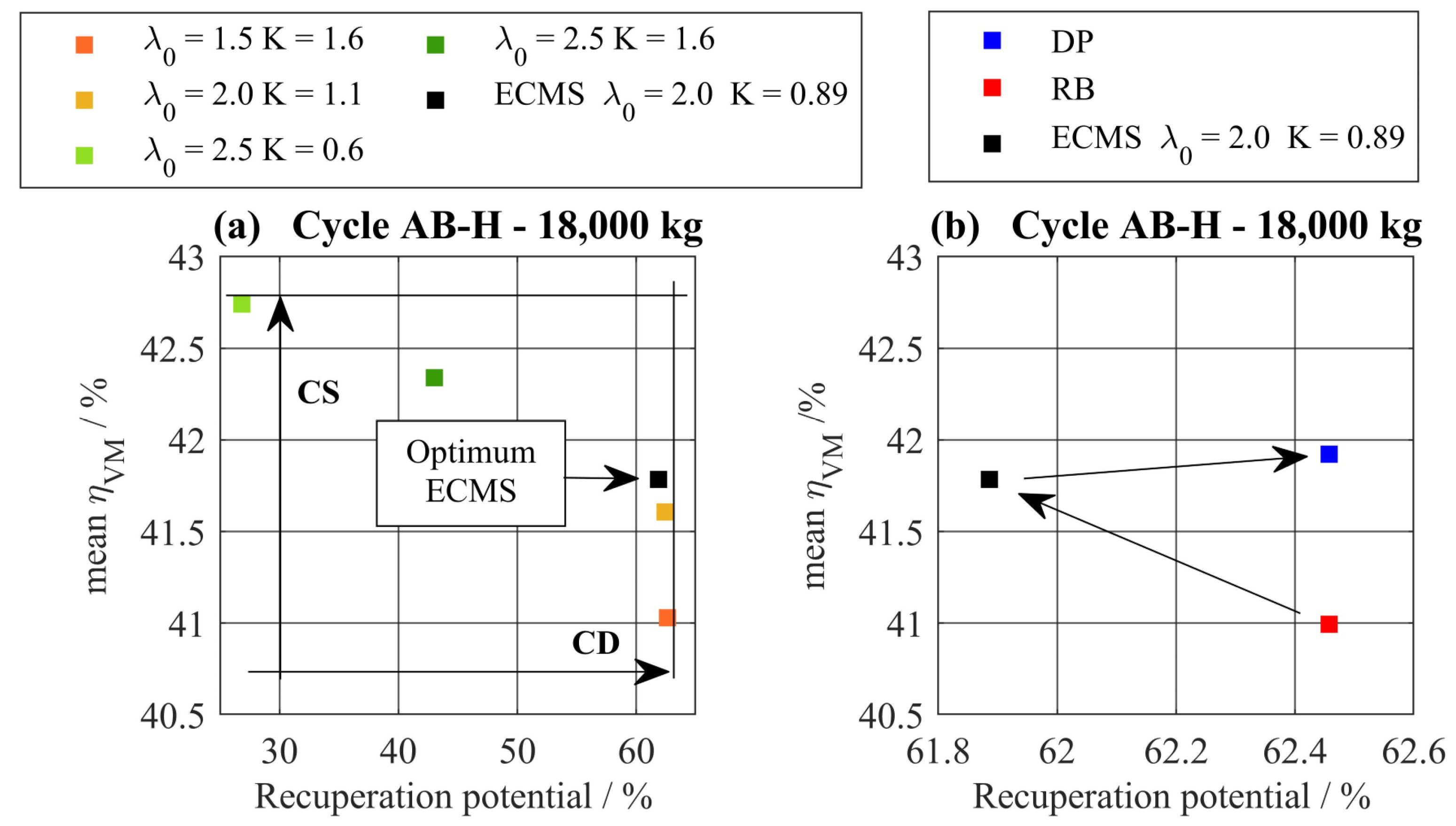
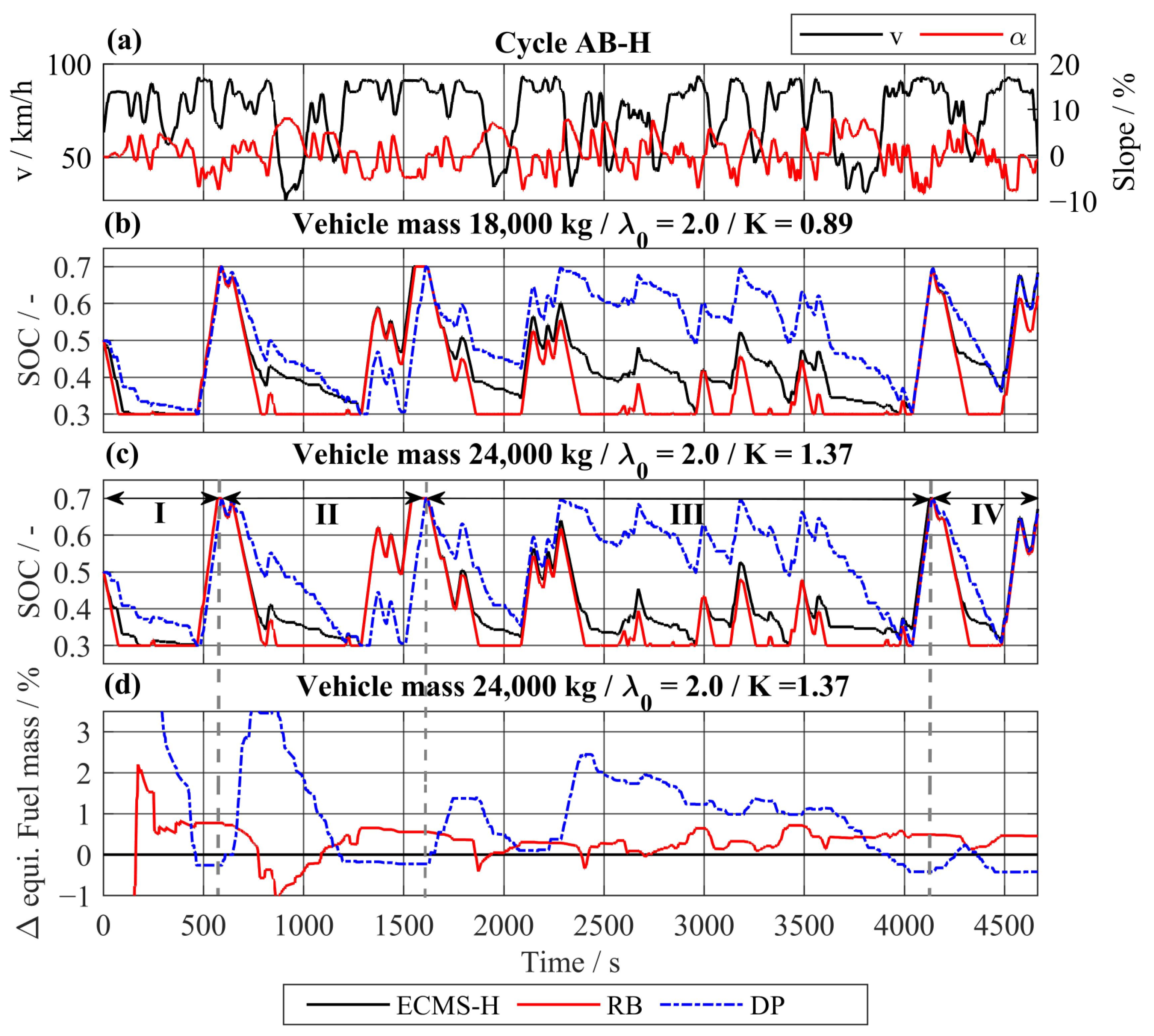

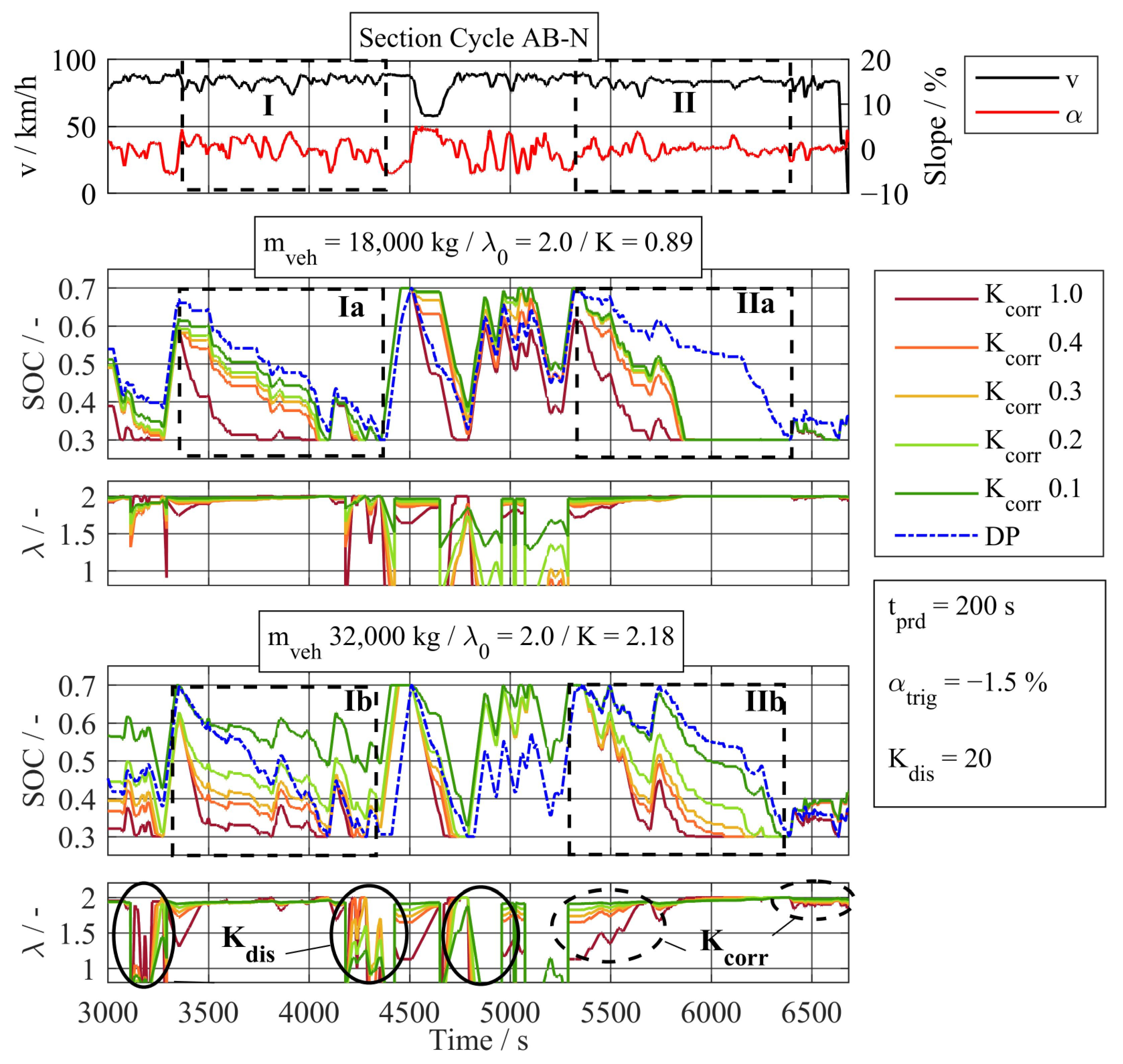

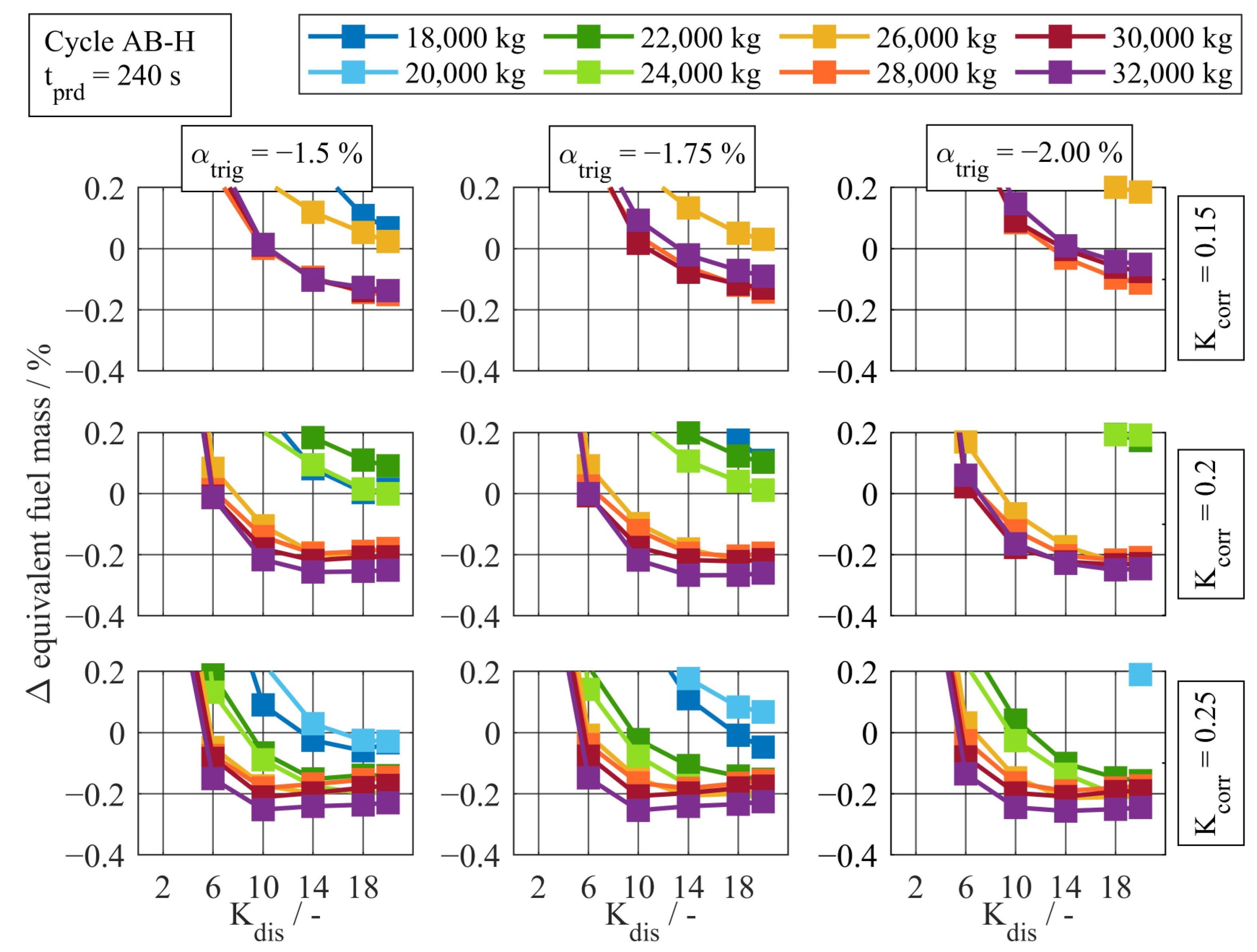
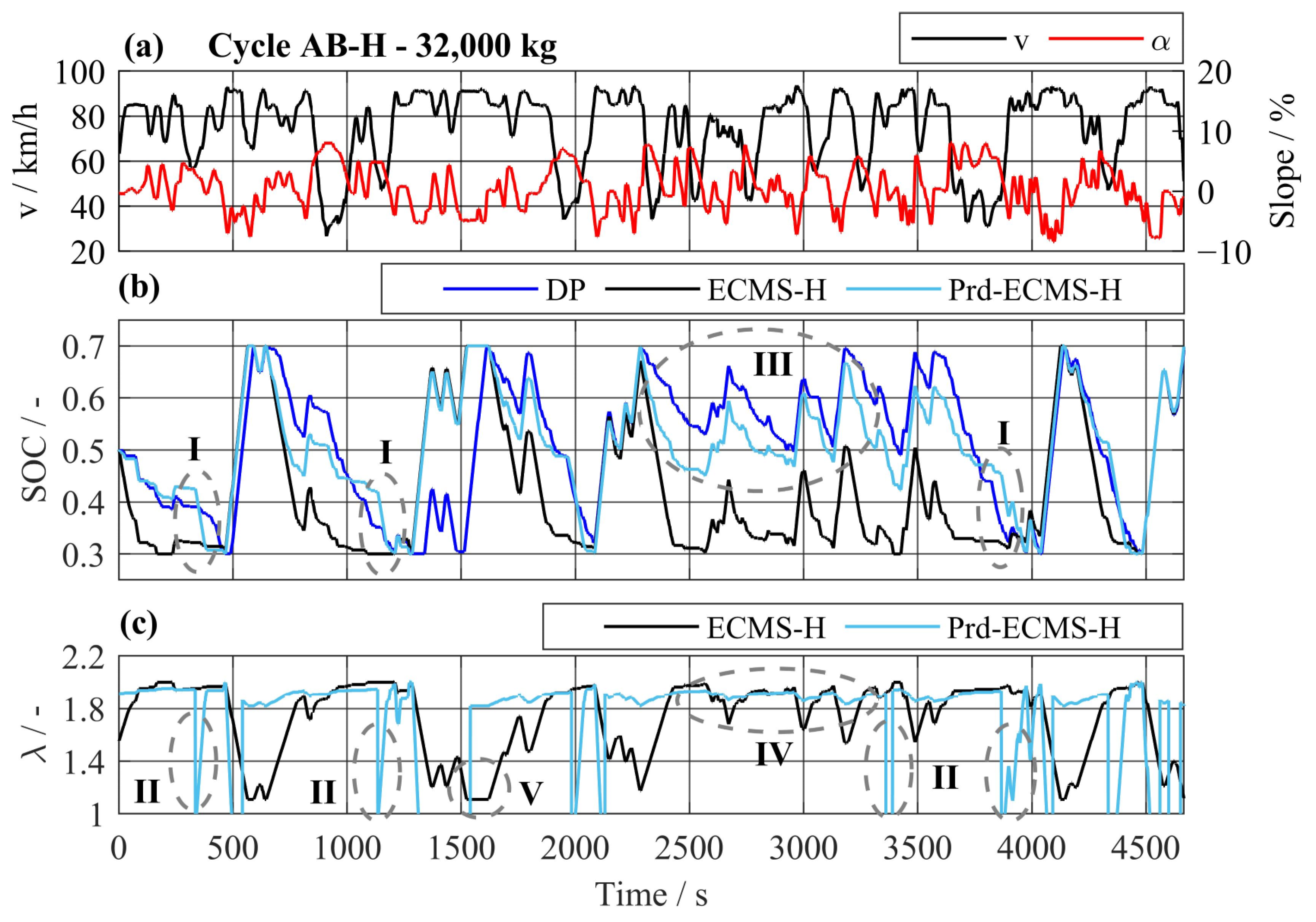
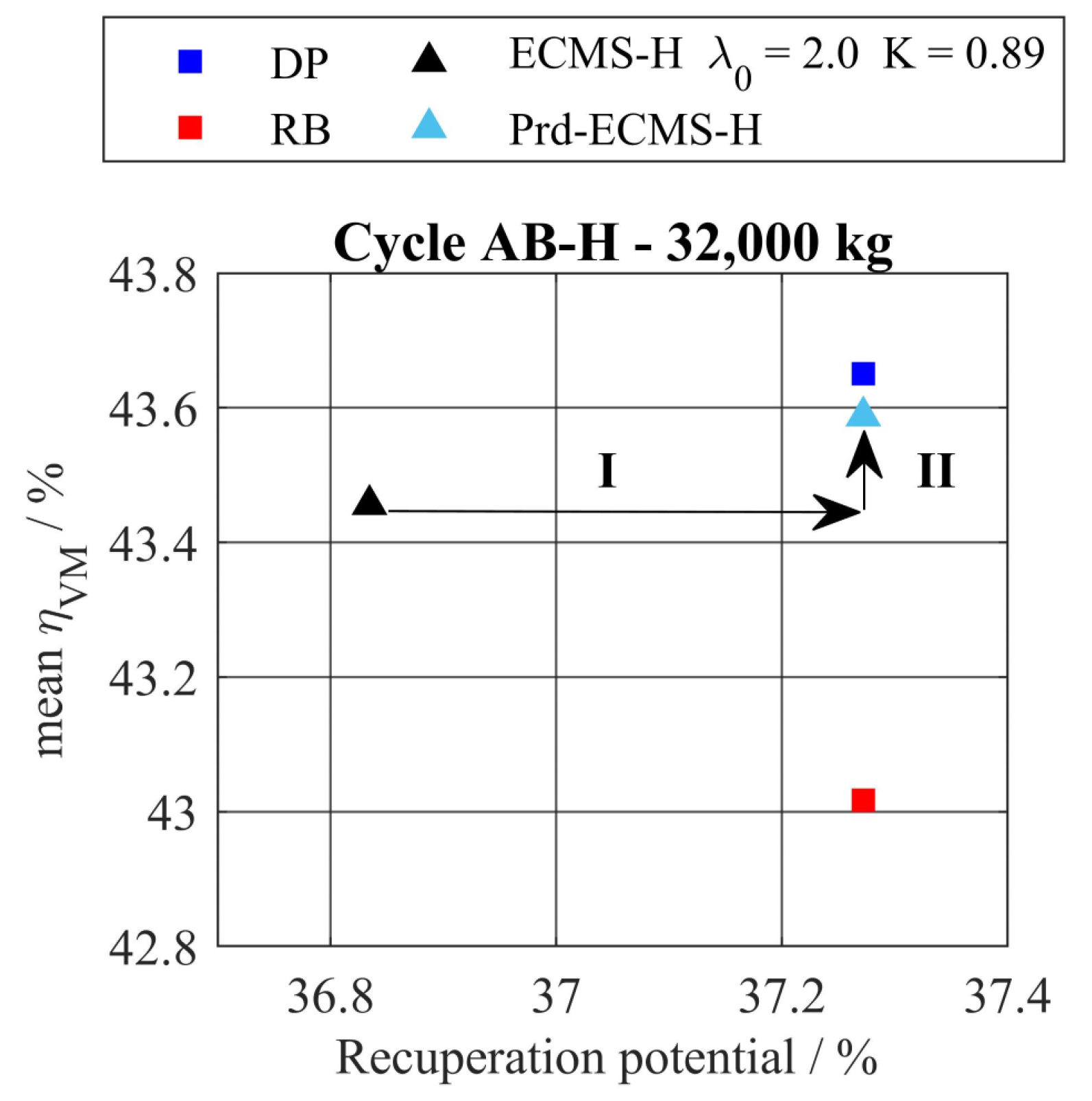
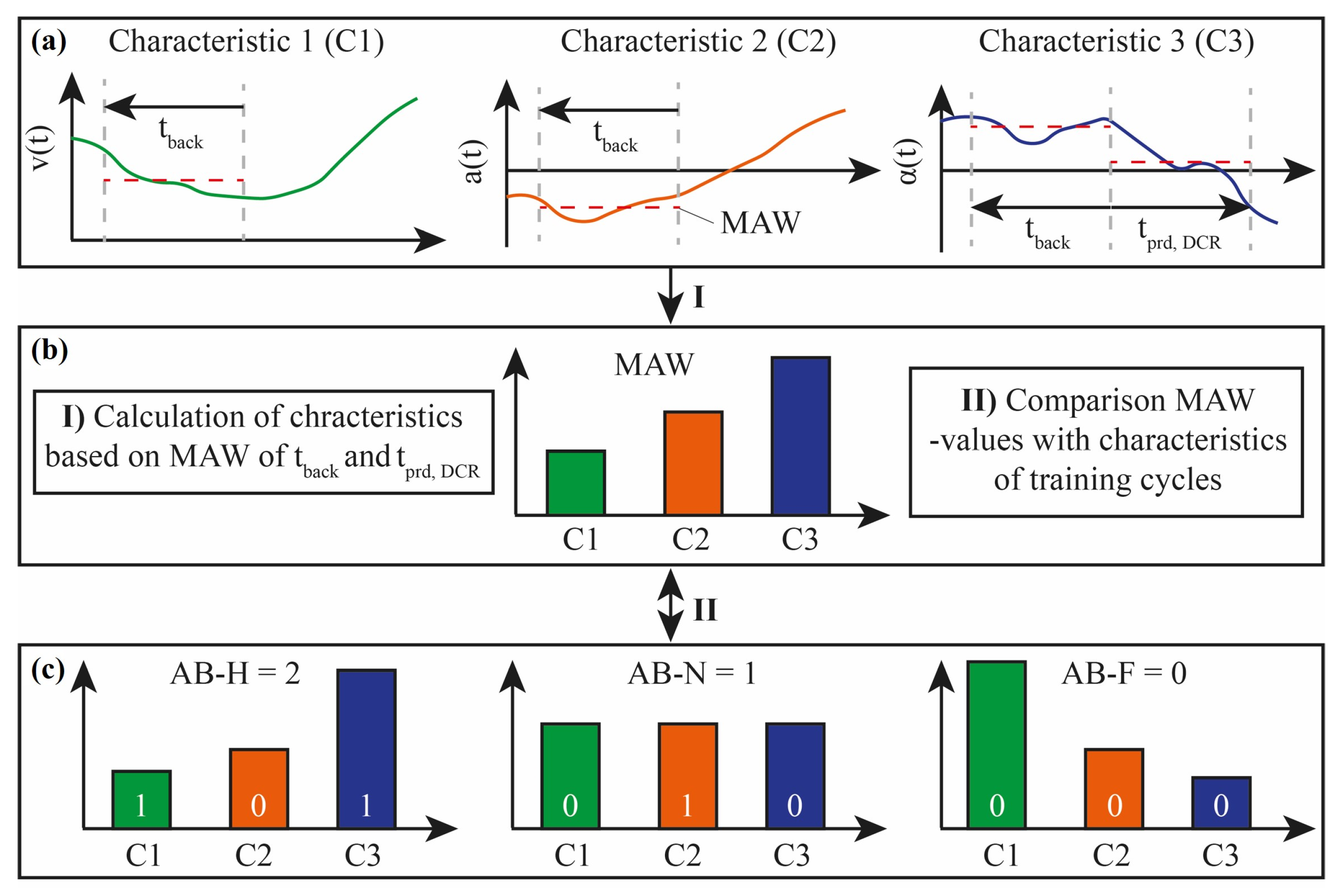
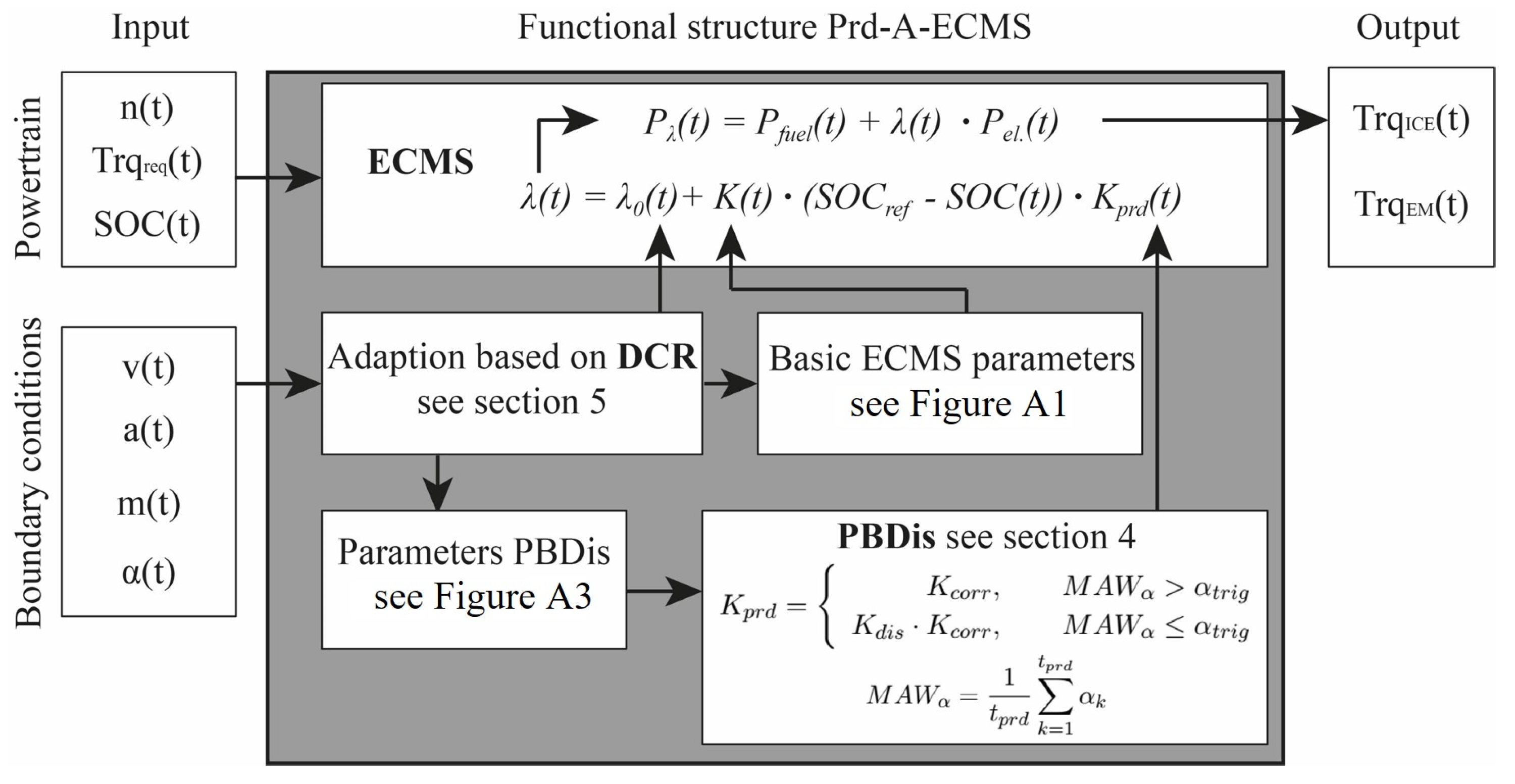




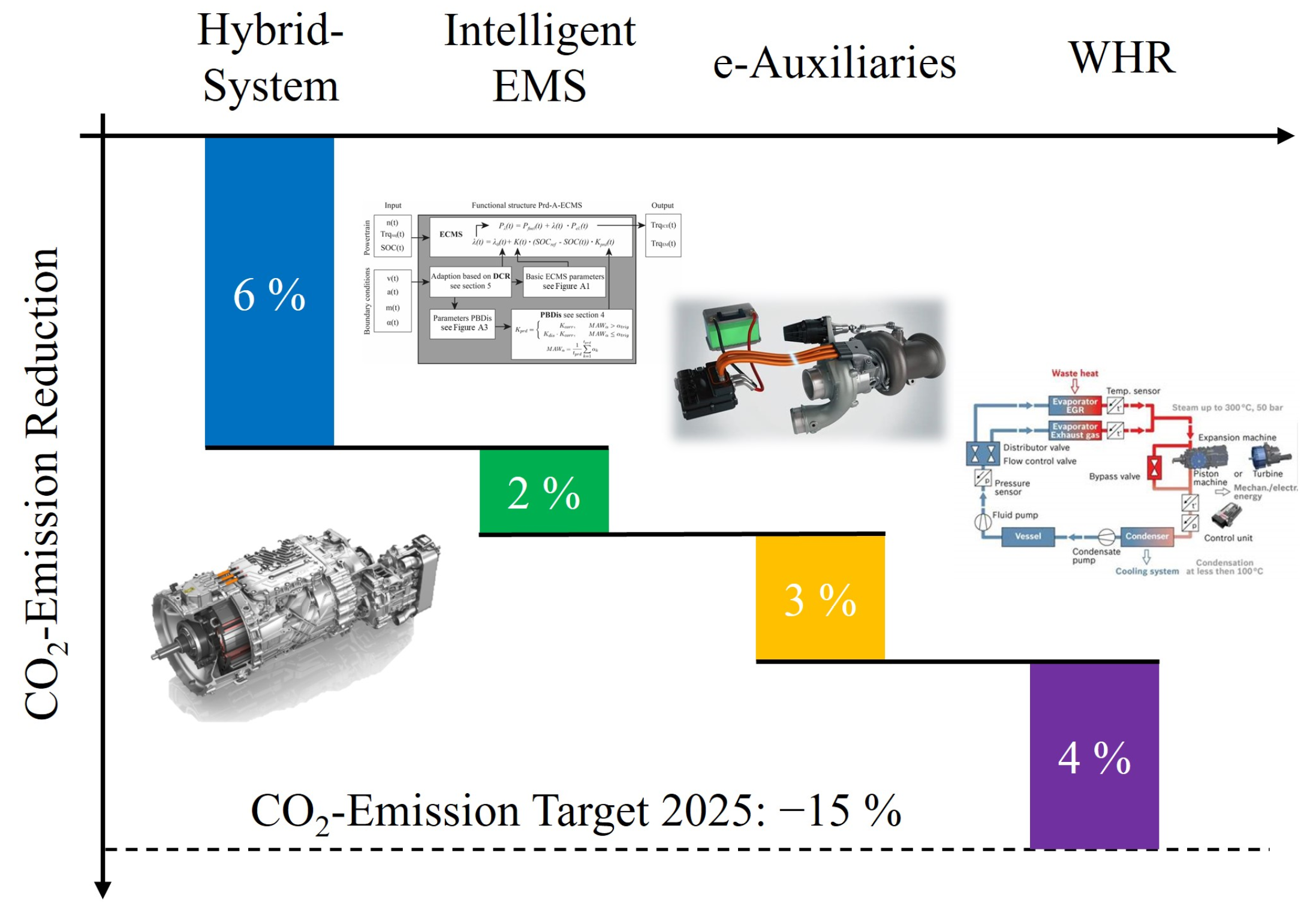

| Generation | K | Equivalent Fuel Mass/kg | Delta to | |
|---|---|---|---|---|
| Optimum/% | ||||
| 1st | 1.5 | 0.6 | 18.0771 | 1.1 |
| 1.5 | 1.6 | 18.0771 | 1.1 | |
| 2 | 1.1 | 17.8803 | 0 | |
| 2.5 | 0.6 | 19.8429 | 10.98 | |
| 2.5 | 1.6 | 18.8636 | 5.5 | |
| 2nd | 1.75 | 1.1 | 18.0703 | 1.09 |
| 2 | 0.85 | 17.8763 | 0 | |
| 2 | 1.35 | 17.897 | 0.12 | |
| 2.25 | 1.1 | 18.5017 | 3.5 | |
| 3rd–7th | … | … | … | … |
| 8th | 1.9961 | 0.8891 | 17.8674 | 0.02 |
| 2 | 0.8852 | 17.8654 | 0.01 | |
| 2 | 0.893 | 17.8645 | 0 | |
| 2.0039 | 0.8891 | 17.8657 | 0.1 |
Disclaimer/Publisher’s Note: The statements, opinions and data contained in all publications are solely those of the individual author(s) and contributor(s) and not of MDPI and/or the editor(s). MDPI and/or the editor(s) disclaim responsibility for any injury to people or property resulting from any ideas, methods, instructions or products referred to in the content. |
© 2023 by the authors. Licensee MDPI, Basel, Switzerland. This article is an open access article distributed under the terms and conditions of the Creative Commons Attribution (CC BY) license (https://creativecommons.org/licenses/by/4.0/).
Share and Cite
Schulze, S.; Feyerl, G.; Pischinger, S. Advanced ECMS for Hybrid Electric Heavy-Duty Trucks with Predictive Battery Discharge and Adaptive Operating Strategy under Real Driving Conditions. Energies 2023, 16, 5171. https://doi.org/10.3390/en16135171
Schulze S, Feyerl G, Pischinger S. Advanced ECMS for Hybrid Electric Heavy-Duty Trucks with Predictive Battery Discharge and Adaptive Operating Strategy under Real Driving Conditions. Energies. 2023; 16(13):5171. https://doi.org/10.3390/en16135171
Chicago/Turabian StyleSchulze, Sven, Günter Feyerl, and Stefan Pischinger. 2023. "Advanced ECMS for Hybrid Electric Heavy-Duty Trucks with Predictive Battery Discharge and Adaptive Operating Strategy under Real Driving Conditions" Energies 16, no. 13: 5171. https://doi.org/10.3390/en16135171
APA StyleSchulze, S., Feyerl, G., & Pischinger, S. (2023). Advanced ECMS for Hybrid Electric Heavy-Duty Trucks with Predictive Battery Discharge and Adaptive Operating Strategy under Real Driving Conditions. Energies, 16(13), 5171. https://doi.org/10.3390/en16135171







